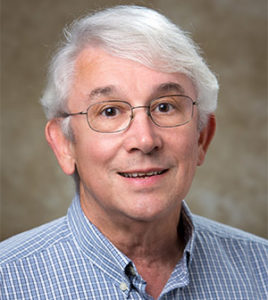James Thomas, PhD
 Education
Education
- BA, Chemistry, Emory University
- PhD, Pharmacology, Biochemistry, University of Alabama at Birmingham
- Postdoctoral Study, Reproductive Enzymology, Washington University School of Medicine
Research Interest
Dr. Thomas has been the Principal Investigator (PI) of several NIH R01 grants that identified key differences in the structure-function of human 3β-HSD1 (expressed in placenta, breast tumors) and human 3β-HSD2 (adrenal cortex, ovary and testis). Chimeric mutations are performed of several non-identical amino acids that are predicted to shift the kinetic profile from that of 3β-HSD1 to 3β-HSD2 (or vice-versa). Kinetic characterization of the chimeric mutant isoenzyme determines if the targeted amino acid is critical to the binding of the ligands associated with that activity. This approach determines the role of each key non-identical amino acid in the kinetic differences measured for substrate utilization, cofactor binding or inhibition affinity of these ligands for human 3β-HSD1 and 3β-HSD2. This structure/function information is used to develop new inhibitors of 3β-HSD1 that spare 3β-HSD2. 3β-HSD1-specific inhibitors that can be used to prevent spontaneous preterm birth or treat ER+ breast cancer.
Selected Publications
- Pham JH, Will CM, Mack VL, Halbert M, Conner EA, Bucholtz KM and Thomas JL: Structure-function relationships for the selective inhibition of human 3β-hydroxysteroid dehydrogenase type 1 by a novel androgen analog. (2017) J Steroid Biochem Molec Biol, 174:257-264. https://doi.org/10.1016/j.jsbmb.2017.10.004
http://www.sciencedirect.com/science/article/pii/S096007601730273X - Thomas JL and Bose HS: Regulation of human 3-beta-hydroxysteroid dehydrogenase type-2 (3bHSD2) by molecular chaperones and the mitochondrial environment affects steroidogenesis. J Steroid Biochem Molec Biol 2015, 151:74-84. http://www.sciencedirect.com/science/article/pii/S0960076014002830
- Thomas JL, Rajapaksha M, Mack VL, DeMars GA, Majzoub JA and Bose HS: Regulation of human 3β-hydroxysteroid dehydrogenase type 2 by adrenal corticosteroids and product-feedback by androstenedione in human adrenarche. J Pharmacol Exp Ther 2015, 352, 67–76.
https://www.ncbi.nlm.nih.gov/pubmed/25355646 - Rajapaksha M, Pawlak, KJ, Prasad M, Thomas JL, Whittal RM, Bose HS. Chaperones Rejuvenate Folding and Activity of 3-beta hydroxysteroid dehydrogenase 2. ACS Chemical Biology 2013, 8, 1000–1008.
http://www.ncbi.nlm.nih.gov/pubmed/23485106 - Thomas JL, Bucholtz KM, Kacsoh B: Selective inhibition of human 3β-hydroxysteroid dehydrogenase type 1 as a potential treatment for breast cancer. J Steroid Biochem Molec Biol 2011, 125:57–65.
http://www.ncbi.nlm.nih.gov/pmc/articles/PMC2999670/ - Thomas JL, Mack VL, Sun J, Terrell JR, Bucholtz KM: The functions of key residues in the inhibitor, substrate and cofactor sites of human 3β-hydroxysteroid dehydrogenase type 1 are validated by mutagenesis. J Steroid Biochem Molec Biol 2010, 120:192-199.
http://www.sciencedirect.com/science/article/pii/S0960076010002153 - Thomas JL, Bucholtz, KM , Sun J, Mack VL, Kacsoh B: Structural basis for the selective inhibition of human 3β-hydroxysteroid dehydrogenase 1 in human breast tumor MCF-7 cells. Mol Cell Endocrinol 2009, 302:174-182.
http://www.ncbi.nlm.nih.gov/pmc/articles/PMC2667100/ - Thomas JL, Mack VL, Glow JA, Moshkelani D, Terrell JR, Bucholtz KM: Structure/function of the inhibition of human 3β-hydroxysteroid dehydrogenase type 1 and type 2 by trilostane. J Steroid Biochem Mol Biol 2008, 111: 66–73.
http://www.ncbi.nlm.nih.gov/pmc/articles/PMC2580795/ - Thomas JL, Huether R, Mack VL, Scaccia LA, Stoner RC, Duax WL: Structure/function of human type 1 3β-hydroxysteroid dehydrogenase: an intrasubunit disulfide bond in the Rossmann-fold domain and a Cys residue in the active site are critical for substrate and coenzyme utilization. J Steroid Biochem Mol Biol 2007, 107:80-87.
- Pletnev VZ, Thomas JL, Rhaney FL, Holt LS, Scaccia LA, Umland TC and Duax WL: Rational Proteomics V: Structure-based mutagenesis has revealed key residues responsible for substrate recognition and catalysis by the dehydrogenase and isomerase activities in human 3β-hydroxysteroid dehydrogenase/isomerase type 1. J Steroid Biochem Mol Biol 2006, 101:50-60.
Grants
- PI, R01 CA114717-21, PLACENTAL 3BETA-HYDROXYSTEROID DEHYDROGENASE/ISOMERASE, 03/01/05-01/31/10 (Mercer University)
The objective of this project was to determine the structural basis for the functional differences between human 3β-HSD1 expressed in breast tumors and placenta compared to 3β-HSD2 in adrenals and gonads. The grant was transferred from NICHD to NCI due to the new focus on breast cancer upon competitive renewal in 2005. - PI, R01 HD020055-17, PLACENTAL 3 BETA-HYDROXYSTEROID DEHYDROGENASE/ISOMERASE, 08/01/00-02/28/05 (Mercer University)
The objective of this project was to investigate the structure/function relationships of human 3β-HSD1 and 3β-HSD2 using mutagenesis with a clinical focus on parturition. - PI, R01 HD020055-13A2, PLACENTAL 3 BETA-HYDROXYSTEROID DEHYDROGENASE/ISOMERASE, 03/01/00-07/31/00 (Washington University in St. Louis)
This grant was the competitive renewal of the 14-year project described below at Washington University School of Medicine that was transferred to Mercer University School of Medicine in August, 2000. - PI, R01 HD020055-12, PLACENTAL 3 BETA-HYDROXYSTEROID DEHYDROGENASE/ISOMERASE, 08/01/85-11/30/99 (Washington University in St. Louis)
This grant was responsible for the original purification of human placental 3β-HSD1 from microsomes and mitochondria and characterization of the purified enzyme by kinetic analyses, affinity labeling and site-directed mutagenesis.
Professional Involvement
- American Society for Biochemistry and Molecular Biology
- American Society for Pharmacology and Experimental Therapeutics
- Sigma Xi
- The Endocrine Society